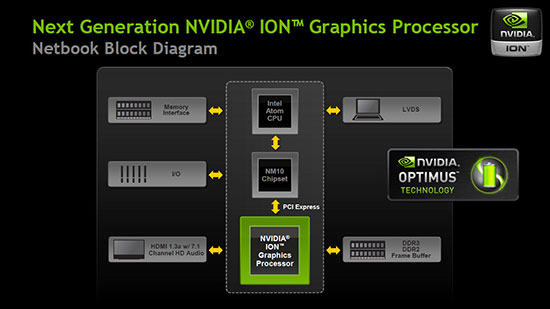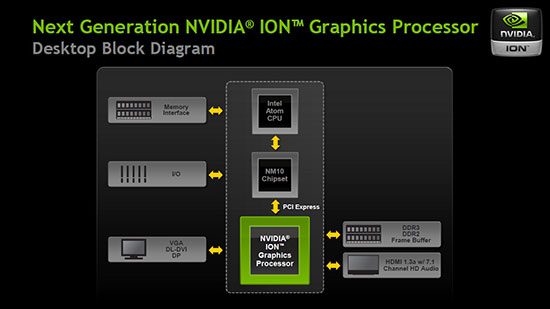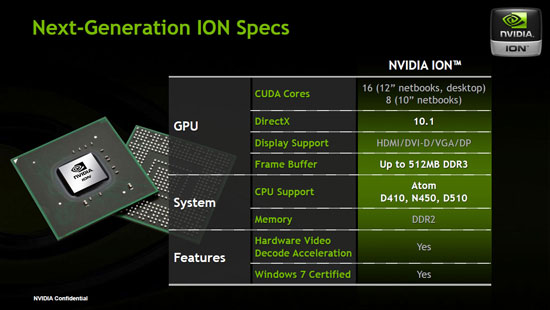NVIDIA's Next Generation ION Announced, Optimus + a 16-core Version
by Jarred Walton on March 2, 2010 12:01 AM ESTGetting Technical with Next Generation ION
Obviously, there are some changes to the core ION design, since the previous version was a chipset with integrated graphics while the new version only has to worry about GPU duties. The manufacturing technology for ION has also shifted from 55nm for the first generation to 40nm hardware; this results in a package size reduction from 35x35mm down to 23x23mm. Outside of clock speeds what we're looking at is essentially a netbook/nettop version of the GeForce G 210M (with half the SPs on certain models—see below), with full DirectX 10.1 support. The memory technology will continue to be DDR2, which comes from the Intel NM10 chipset.
Since NG-ION is now a discrete GPU, it also comes with up to 512MB of dedicated DDR3 memory. This alone should provide better performance than the old version, as there's now more bandwidth to go around. NVIDIA isn't disclosing clock speeds yet, but given the process shrink we would expect moderately higher clocks. That probably won't matter much for complex games, as the Atom CPU will continue to be a bottleneck, but it will help with some games and CUDA applications. NVIDIA says that in general NG-ION will be 50 to 100% faster than the original ION.
Like the previous iteration of ION, there will be two versions of ION. Nettop IONs will come with 16 SPs (aka CUDA Cores), while netbooks will come with either 16 SPs or 8 SPs. The 8 SP version is designed specifically to fit within the thermal constraints of a 10.1" chassis, so we'll actually see 10" netbooks with ION this time around. Fewer CUDA Cores may impact gaming performance (depending on the title) and CUDA applications, but NVIDIA says Blu-ray playback will continue to work, so by extension HD video decoding won't be a problem.
The one aspect of the technology that NVIDIA wouldn't discuss extensively is how Optimus works within the bandwidth constraints imposed by the NM10 chipset. Just to clarify, NM10 provides just four PCI Express 1.1 lanes, and while a manufacturer could choose to use all of those for the ION GPU NVIDIA says most will use a single link, leaving the other lanes open for additional devices. PCIe 1.1 provides 250MB/s of bidirectional bandwidth on each link, so that means Optimus will have to work within that constraint. Optimus copies content from the GPU memory to the system memory directly, to avoid any issues with flickering displays, but that means NG-ION will need to transmit a lot of data over a relatively narrow link.
Driving a low resolution 1024x600 LCD at 60FPS isn't a problem, but even at 1366x768 we are at the limits of x1 bandwidth (such a display would require 251.78MB/s to be exact). NVIDIA says that NG-ION won't have any trouble driving up to 1080p displays, so naturally we were curious how they manage to get 1920x1080x32-bit @ 60FPS (497.66MB/s) over a 250MB/s link. For now, unfortunately, they aren't saying, other than that there's some "intelligent work" going on in the drivers. Real-time compression is one option, and if you only transmit the meaningful 24-bits of color you can save 33% of the total bandwidth. All we know is that NVIDIA says it works, that the content isn't compressed (presumably that means no lossy compression, as clearly there has to be some form of compression happening), and that they're not overclocking the PCIe bus. In short, Optimus has some "special sauce" that NVIDIA doesn't want to disclose (yet?).
Update: The answer was staring me in the face, but I missed it. NVIDIA was kind enough to provide the remaining information. If you read below, HDMI requires the GPU, since the Atom IGP doesn't support HDMI output. That solves any question of 1080p support, since the only thing going over the x1 link at that point is the compressed video stream. For content running on the laptop LCD, the maximum resolution supported by the Atom LVDS controller is 1366x768, so NVIDIA can do two things. First, any content at a higher resolution (e.g. 1080p Blu-ray) can be scaled down to 1366x768 before going over the x1 PCI-E bus. Second, most videos are at 30p or 24p, so 1366x768x32-bit @ 30FPS is well withing the bandwidth constraints of an x1 link (125.9MB/s). For 1366x768 @ 60FPS, rendering internally at 32-bit (with the Alpha/Z/Bump channel) and then transmitting the final 24-bits of color data still seems like a good solution, but NVIDIA didn't clarify if they're doing anything special for that case or if they're just saturating the x1 link.
Speaking of Optimus, that also means that NG-ION netbooks are limited to Win7 systems. This won't be a concern for most users, but know in advance that installing Linux on such a netbook would mean the loss of your GPU functionality (short of some enterprising individuals figuring out how to do Optimus on their own, which I wouldn't put past the Linux community given time). NVIDIA informs us that there are currently no plans for Optimus on desktops or on other OSes.
One item that created a bit of confusion for us was the Windows 7 Starter requirement. NVIDIA is able to handle the Aero UI with ION, obviously, but what does that mean for Optimus? If GMA 3150 can't run Aero on its own, Optimus would have to constantly power up the GPU to handle Aero effects. That would be counterproductive and as far as we can tell, the real issue with Windows 7 Starter comes down to manufacturers wanting to save money by going with Starter instead of install Home Premium. GMA 3150 can handle Aero (albeit barely), so Optimus doesn't need to worry about using the GPU for standard Windows applications with Pineview CPUs like the N450. Whether all ION netbooks will require Home Premium isn't clear, but we see no reason to pair such a netbook with Win7 Starter.
Finally, because of the IGP restrictions on the GMA 3150, NG-ION will require the GPU to be active any time an HDMI connection is used. GMA 3150 does not have support for HDMI at all, so the HDMI connection will run solely off the ION GPU. Considering HDMI means you're tethered to an external display this shouldn't be a problem, as you can easily plug in the netbook. Second, GMA 3150/NM10 has a resolution limit of 1366x768 for LVDS and 1400x1050 for VGA, so higher resolutions will need ION—but again, higher resolutions will only be available with an external display. The VGA connection is supposed to come from the IGP, so the resolution limit for VGA will remain in effect.


















34 Comments
View All Comments
erple2 - Tuesday, March 2, 2010 - link
To be fair, launching FireFox on my Ubuntu 9.10 desktop (a P4 2.53 GHz, 768MB computer with a 9800Pro gfx card) also pegs the CPU at 100%... Maybe that desktop CPU is more than 5 years old?JarredWalton - Tuesday, March 2, 2010 - link
The only thing preventing people from using CULV instead of Atom is cost, and as you may have guessed from my last article on the subject (CULV Roundup: Who Needs Atom?) I'm all for skipping Atom and getting CULV instead. If you need graphics, then you go with CULV+G210M with stuff like the ASUS UL series. I also find Atom to be painfully slow, but I suppose I'm more demanding of my PC than a lot of users.damianrobertjones - Tuesday, March 2, 2010 - link
According to apple the Netbook is set to fail? Then we get a graph stating that a high number of people actually use and like Netbooks?Should we believe the trend or listen to a guy that will sell you ANYTHING at a higher than normal price?
kevinqian - Tuesday, March 2, 2010 - link
There seems to be an influx of new Core i3/i5 laptops coming in at around $500-600 mark. Granted, they are 15.6" and larger LCD. At that price, it essentially prices out CULV laptops selling at similar prices. So $400 gets you an ION netbook and $500 gets you a full blown Core i3 laptop. Did someone at Intel screw up their market segmentation?Lonyo - Tuesday, March 2, 2010 - link
How did Intel screw up market segmentation?NV are the ones screwing up by adding cost to what should be an inexpensive platform.
$400 for an ION netbook isn't $400 for a netbook, and it has nothing to do with Intel. In fact, the less ION the better for them.
JarredWalton - Tuesday, March 2, 2010 - link
Atom = $300 to $400 with long battery life and low performanceCULV = $500 to $600 with long battery life and three times the performance of Atom
Core i3/i5 = $500 to $1000 (or more) with less than half the battery life of CULV but more than twice the performance.
When Core i3/i5 CULV arrives, I expect it won't be significantly faster than current CULV... maybe 25% faster (at most 75% in certain scenarios)? So that's the market segmentation Intel is going for, more or less.
kevinqian - Tuesday, March 2, 2010 - link
So it comes down to pick your poison at the $500-600 price point. Do you want fast performance with a larger display or slower performance and more portability. I guess if you want both (performance and portability), you gotta step up to a future MBP or Lenovo T4xxs.Penti - Tuesday, March 2, 2010 - link
Atom should mostly move back into the embedded space now. It's great for that.CULV is great for consumers especially ones flash gets official hw acceleration. There's no CULV that can't be accelerated, no confusion. Atom with Broadcom or ION and W7HP will cost 400-450 and the costumers must make an active choice.
AmdInside - Tuesday, March 2, 2010 - link
I think the technology is just too advanced to just throw it out there for all desktops. Look at how long it has taken NVIDIA to get from their first Hybrid to Optimus. Notebooks and OEM systems are more controlled environments. I personally would not want to see it in a desktop because it would just be another feature that can fail to work properly. ATI and NVIDIA have gotten pretty good at reducing power requirements when the GPU is not doing much. I think overtime they will get even better, especially when you see how little power Tegra consumes.Doormat - Tuesday, March 2, 2010 - link
One of the rumors about the ION was Nvidia was recommending OCing the PCIe link in the netbook. An extra 10% gets 275MB/s.Also, the whole "no other OSes" line was really depressing.